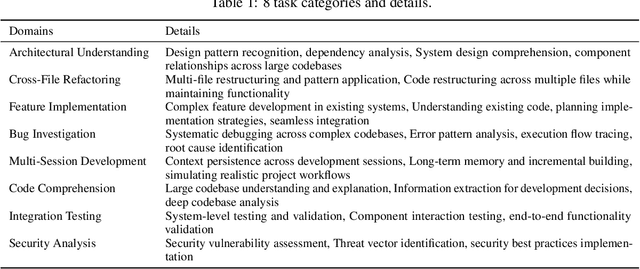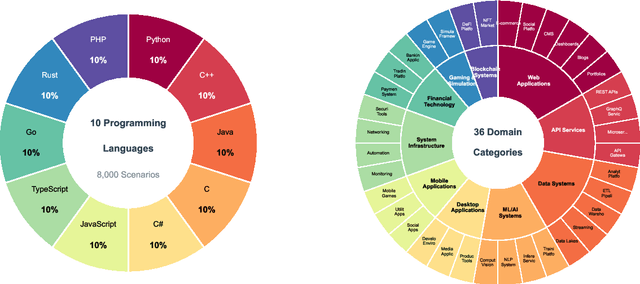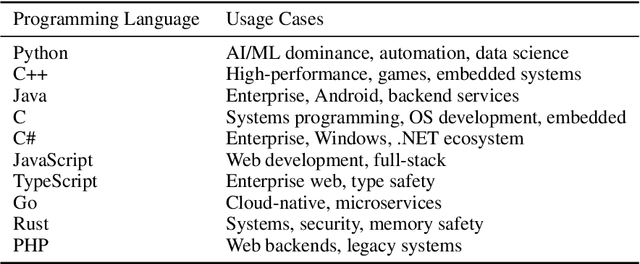Jianguo Zhang
Grounded Test-Time Adaptation for LLM Agents
Nov 06, 2025Abstract:Large language model (LLM)-based agents struggle to generalize to novel and complex environments, such as unseen websites or new sets of functions, due to a fundamental mismatch between their pre-training and test-time conditions. This challenge stems from two distinct failure modes: a syntactic misunderstanding of environment-specific components like observation formats, and a semantic misunderstanding of state-transition dynamics, which are only revealed at test time. To address these issues, we propose two distinct and complementary strategies for adapting LLM agents by leveraging environment-specific information available during deployment. First, an online distributional adaptation method parameterizes environmental nuances by learning a lightweight adaptation vector that biases the model's output distribution, enabling rapid alignment with an environment response format. Second, a deployment-time dynamics grounding method employs a persona-driven exploration phase to systematically probe and learn the environment's causal dynamics before task execution, equipping the agent with a nonparametric world model. We evaluate these strategies across diverse agentic benchmarks, including function calling and web navigation. Our empirical results show the effectiveness of both strategies across all benchmarks with minimal computational cost. We find that dynamics grounding is particularly effective in complex environments where unpredictable dynamics pose a major obstacle, demonstrating a robust path toward more generalizable and capable LLM-based agents. For example, on the WebArena multi-site split, this method increases the agent's success rate from 2% to 23%.
ToolLibGen: Scalable Automatic Tool Creation and Aggregation for LLM Reasoning
Oct 09, 2025



Abstract:Large Language Models (LLMs) equipped with external tools have demonstrated enhanced performance on complex reasoning tasks. The widespread adoption of this tool-augmented reasoning is hindered by the scarcity of domain-specific tools. For instance, in domains such as physics question answering, suitable and specialized tools are often missing. Recent work has explored automating tool creation by extracting reusable functions from Chain-of-Thought (CoT) reasoning traces; however, these approaches face a critical scalability bottleneck. As the number of generated tools grows, storing them in an unstructured collection leads to significant retrieval challenges, including an expanding search space and ambiguity between function-related tools. To address this, we propose a systematic approach to automatically refactor an unstructured collection of tools into a structured tool library. Our system first generates discrete, task-specific tools and clusters them into semantically coherent topics. Within each cluster, we introduce a multi-agent framework to consolidate scattered functionalities: a code agent refactors code to extract shared logic and creates versatile, aggregated tools, while a reviewing agent ensures that these aggregated tools maintain the complete functional capabilities of the original set. This process transforms numerous question-specific tools into a smaller set of powerful, aggregated tools without loss of functionality. Experimental results demonstrate that our approach significantly improves tool retrieval accuracy and overall reasoning performance across multiple reasoning tasks. Furthermore, our method shows enhanced scalability compared with baselines as the number of question-specific increases.
SpikingMamba: Towards Energy-Efficient Large Language Models via Knowledge Distillation from Mamba
Oct 06, 2025



Abstract:Large Language Models (LLMs) have achieved remarkable performance across tasks but remain energy-intensive due to dense matrix operations. Spiking neural networks (SNNs) improve energy efficiency by replacing dense matrix multiplications with sparse accumulations. Their sparse spike activity enables efficient LLMs deployment on edge devices. However, prior SNN-based LLMs often sacrifice performance for efficiency, and recovering accuracy typically requires full pretraining, which is costly and impractical. To address this, we propose SpikingMamba, an energy-efficient SNN-based LLMs distilled from Mamba that improves energy efficiency with minimal accuracy sacrifice. SpikingMamba integrates two key components: (a) TI-LIF, a ternary-integer spiking neuron that preserves semantic polarity through signed multi-level spike representations. (b) A training-exclusive Smoothed Gradient Compensation (SGC) path mitigating quantization loss while preserving spike-driven efficiency. We employ a single-stage distillation strategy to transfer the zero-shot ability of pretrained Mamba and further enhance it via reinforcement learning (RL). Experiments show that SpikingMamba-1.3B achieves a 4.76$\times$ energy benefit, with only a 4.78\% zero-shot accuracy gap compared to the original Mamba, and achieves a further 2.55\% accuracy improvement after RL.
The best performance in the CARE 2025 -- Liver Task (LiSeg-Contrast): Contrast-Aware Semi-Supervised Segmentation with Domain Generalization and Test-Time Adaptation
Oct 05, 2025



Abstract:Accurate liver segmentation from contrast-enhanced MRI is essential for diagnosis, treatment planning, and disease monitoring. However, it remains challenging due to limited annotated data, heterogeneous enhancement protocols, and significant domain shifts across scanners and institutions. Traditional image-to-image translation frameworks have made great progress in domain generalization, but their application is not straightforward. For example, Pix2Pix requires image registration, and cycle-GAN cannot be integrated seamlessly into segmentation pipelines. Meanwhile, these methods are originally used to deal with cross-modality scenarios, and often introduce structural distortions and suffer from unstable training, which may pose drawbacks in our single-modality scenario. To address these challenges, we propose CoSSeg-TTA, a compact segmentation framework for the GED4 (Gd-EOB-DTPA enhanced hepatobiliary phase MRI) modality built upon nnU-Netv2 and enhanced with a semi-supervised mean teacher scheme to exploit large amounts of unlabeled volumes. A domain adaptation module, incorporating a randomized histogram-based style appearance transfer function and a trainable contrast-aware network, enriches domain diversity and mitigates cross-center variability. Furthermore, a continual test-time adaptation strategy is employed to improve robustness during inference. Extensive experiments demonstrate that our framework consistently outperforms the nnU-Netv2 baseline, achieving superior Dice score and Hausdorff Distance while exhibiting strong generalization to unseen domains under low-annotation conditions.
LoCoBench: A Benchmark for Long-Context Large Language Models in Complex Software Engineering
Sep 11, 2025



Abstract:The emergence of long-context language models with context windows extending to millions of tokens has created new opportunities for sophisticated code understanding and software development evaluation. We propose LoCoBench, a comprehensive benchmark specifically designed to evaluate long-context LLMs in realistic, complex software development scenarios. Unlike existing code evaluation benchmarks that focus on single-function completion or short-context tasks, LoCoBench addresses the critical evaluation gap for long-context capabilities that require understanding entire codebases, reasoning across multiple files, and maintaining architectural consistency across large-scale software systems. Our benchmark provides 8,000 evaluation scenarios systematically generated across 10 programming languages, with context lengths spanning 10K to 1M tokens, a 100x variation that enables precise assessment of long-context performance degradation in realistic software development settings. LoCoBench introduces 8 task categories that capture essential long-context capabilities: architectural understanding, cross-file refactoring, multi-session development, bug investigation, feature implementation, code comprehension, integration testing, and security analysis. Through a 5-phase pipeline, we create diverse, high-quality scenarios that challenge LLMs to reason about complex codebases at unprecedented scale. We introduce a comprehensive evaluation framework with 17 metrics across 4 dimensions, including 8 new evaluation metrics, combined in a LoCoBench Score (LCBS). Our evaluation of state-of-the-art long-context models reveals substantial performance gaps, demonstrating that long-context understanding in complex software development represents a significant unsolved challenge that demands more attention. LoCoBench is released at: https://github.com/SalesforceAIResearch/LoCoBench.
UserBench: An Interactive Gym Environment for User-Centric Agents
Jul 29, 2025Abstract:Large Language Models (LLMs)-based agents have made impressive progress in reasoning and tool use, enabling them to solve complex tasks. However, their ability to proactively collaborate with users, especially when goals are vague, evolving, or indirectly expressed, remains underexplored. To address this gap, we introduce UserBench, a user-centric benchmark designed to evaluate agents in multi-turn, preference-driven interactions. UserBench features simulated users who start with underspecified goals and reveal preferences incrementally, requiring agents to proactively clarify intent and make grounded decisions with tools. Our evaluation of leading open- and closed-source LLMs reveals a significant disconnect between task completion and user alignment. For instance, models provide answers that fully align with all user intents only 20% of the time on average, and even the most advanced models uncover fewer than 30% of all user preferences through active interaction. These results highlight the challenges of building agents that are not just capable task executors, but true collaborative partners. UserBench offers an interactive environment to measure and advance this critical capability.
Unsupervised Part Discovery via Descriptor-Based Masked Image Restoration with Optimized Constraints
Jul 16, 2025Abstract:Part-level features are crucial for image understanding, but few studies focus on them because of the lack of fine-grained labels. Although unsupervised part discovery can eliminate the reliance on labels, most of them cannot maintain robustness across various categories and scenarios, which restricts their application range. To overcome this limitation, we present a more effective paradigm for unsupervised part discovery, named Masked Part Autoencoder (MPAE). It first learns part descriptors as well as a feature map from the inputs and produces patch features from a masked version of the original images. Then, the masked regions are filled with the learned part descriptors based on the similarity between the local features and descriptors. By restoring these masked patches using the part descriptors, they become better aligned with their part shapes, guided by appearance features from unmasked patches. Finally, MPAE robustly discovers meaningful parts that closely match the actual object shapes, even in complex scenarios. Moreover, several looser yet more effective constraints are proposed to enable MPAE to identify the presence of parts across various scenarios and categories in an unsupervised manner. This provides the foundation for addressing challenges posed by occlusion and for exploring part similarity across multiple categories. Extensive experiments demonstrate that our method robustly discovers meaningful parts across various categories and scenarios. The code is available at the project https://github.com/Jiahao-UTS/MPAE.
Cross-DINO: Cross the Deep MLP and Transformer for Small Object Detection
May 28, 2025Abstract:Small Object Detection (SOD) poses significant challenges due to limited information and the model's low class prediction score. While Transformer-based detectors have shown promising performance, their potential for SOD remains largely unexplored. In typical DETR-like frameworks, the CNN backbone network, specialized in aggregating local information, struggles to capture the necessary contextual information for SOD. The multiple attention layers in the Transformer Encoder face difficulties in effectively attending to small objects and can also lead to blurring of features. Furthermore, the model's lower class prediction score of small objects compared to large objects further increases the difficulty of SOD. To address these challenges, we introduce a novel approach called Cross-DINO. This approach incorporates the deep MLP network to aggregate initial feature representations with both short and long range information for SOD. Then, a new Cross Coding Twice Module (CCTM) is applied to integrate these initial representations to the Transformer Encoder feature, enhancing the details of small objects. Additionally, we introduce a new kind of soft label named Category-Size (CS), integrating the Category and Size of objects. By treating CS as new ground truth, we propose a new loss function called Boost Loss to improve the class prediction score of the model. Extensive experimental results on COCO, WiderPerson, VisDrone, AI-TOD, and SODA-D datasets demonstrate that Cross-DINO efficiently improves the performance of DETR-like models on SOD. Specifically, our model achieves 36.4% APs on COCO for SOD with only 45M parameters, outperforming the DINO by +4.4% APS (36.4% vs. 32.0%) with fewer parameters and FLOPs, under 12 epochs training setting. The source codes will be available at https://github.com/Med-Process/Cross-DINO.
Open-Det: An Efficient Learning Framework for Open-Ended Detection
May 27, 2025Abstract:Open-Ended object Detection (OED) is a novel and challenging task that detects objects and generates their category names in a free-form manner, without requiring additional vocabularies during inference. However, the existing OED models, such as GenerateU, require large-scale datasets for training, suffer from slow convergence, and exhibit limited performance. To address these issues, we present a novel and efficient Open-Det framework, consisting of four collaborative parts. Specifically, Open-Det accelerates model training in both the bounding box and object name generation process by reconstructing the Object Detector and the Object Name Generator. To bridge the semantic gap between Vision and Language modalities, we propose a Vision-Language Aligner with V-to-L and L-to-V alignment mechanisms, incorporating with the Prompts Distiller to transfer knowledge from the VLM into VL-prompts, enabling accurate object name generation for the LLM. In addition, we design a Masked Alignment Loss to eliminate contradictory supervision and introduce a Joint Loss to enhance classification, resulting in more efficient training. Compared to GenerateU, Open-Det, using only 1.5% of the training data (0.077M vs. 5.077M), 20.8% of the training epochs (31 vs. 149), and fewer GPU resources (4 V100 vs. 16 A100), achieves even higher performance (+1.0% in APr). The source codes are available at: https://github.com/Med-Process/Open-Det.
WorldGenBench: A World-Knowledge-Integrated Benchmark for Reasoning-Driven Text-to-Image Generation
May 02, 2025Abstract:Recent advances in text-to-image (T2I) generation have achieved impressive results, yet existing models still struggle with prompts that require rich world knowledge and implicit reasoning: both of which are critical for producing semantically accurate, coherent, and contextually appropriate images in real-world scenarios. To address this gap, we introduce \textbf{WorldGenBench}, a benchmark designed to systematically evaluate T2I models' world knowledge grounding and implicit inferential capabilities, covering both the humanities and nature domains. We propose the \textbf{Knowledge Checklist Score}, a structured metric that measures how well generated images satisfy key semantic expectations. Experiments across 21 state-of-the-art models reveal that while diffusion models lead among open-source methods, proprietary auto-regressive models like GPT-4o exhibit significantly stronger reasoning and knowledge integration. Our findings highlight the need for deeper understanding and inference capabilities in next-generation T2I systems. Project Page: \href{https://dwanzhang-ai.github.io/WorldGenBench/}{https://dwanzhang-ai.github.io/WorldGenBench/}
 Add to Chrome
Add to Chrome Add to Firefox
Add to Firefox Add to Edge
Add to Edge